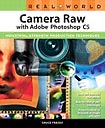Book Review: Real World Camera Raw with Adobe Photoshop CS

Having read Out of Gamut: Calibrating Camera Raw in Photoshop CS on Creative Pro back in May and then seeing subsequent rumblings that this information was from a new Real World book, I was excited about Real World Camera Raw with Adobe Photoshop CS, by Bruce Fraser, before it was even printed. The Real World series of books--of which I've read several--focuses on getting the job done; the tagline to these books is "industrial-strength production techniques." By focusing on getting the task done, these books show and tell what you need to know to create a productive workflow.
Real World Camera Raw is no different from the rest of the series. By first detailing some background information about how the raw format works, proceeding to basic use of the Camera Raw plugin, and continuing with advanced use and automation, I was left with a thorough understanding of how to better use my camera, Camera Raw and Photoshop CS. While this book is aimed at the intermediate to advanced user, I would say that anybody whose camera shoots in a raw format can make good use of this book and its information.
Despite there being seven chapters covering distinctly different aspects of working with the raw format, I see this book as three separate sections: the raw format, using Camera Raw, and advanced use of Camera Raw.
Chapter 1 (Digital Camera Raw) and chapter 2 (How Camera Raw Works) are both excellent introductions to the raw format and the pre- and post-processing those files require. The techniques and ideas described here apply no matter what raw converter is used, making them informative chapters for anybody who shoots raw.
Chapter 3 (Using Camera Raw) is what really details the plugin's capabilities. Including specific recommendations for the order of adjustments and starting points, as well as using modifier keys (alt/option) to further tune the image, makes it easy to get the best results possible. Showing how to save and reuse global settings and partial settings (called "subsets") makes tuning Camera Raw to your camera easy. Detailed use of the Calibrate tab makes getting the desired color easier than expected.
The remainder of the book (chapter 4, The File Browser; 5, It's All About the Workflow; 6, Understanding Metadata; and 7, Exploiting Automation) cover advanced use of Camera Raw and Photoshop CS. Several specific examples are given, with step-by-step instruction, of how to complete different tasks such as batch processing folders full of raw files into TIFFs for print or JPEGs for web use, and tagging a folder of images with keywords. The end result of these chapters is being able to set up Photoshop to do all the basic image processing for you without assistance from you.
As with the other Real World books, this one is very dense. Every sentence has an important piece of information that can help you effectively and efficiently use Camera Raw and the raw format to create a great photo. I see myself re-reading and referencing many sections of the book often.

Share Your Thoughts (